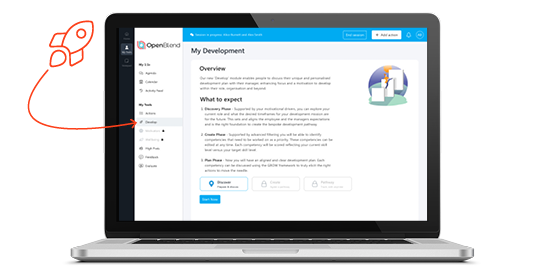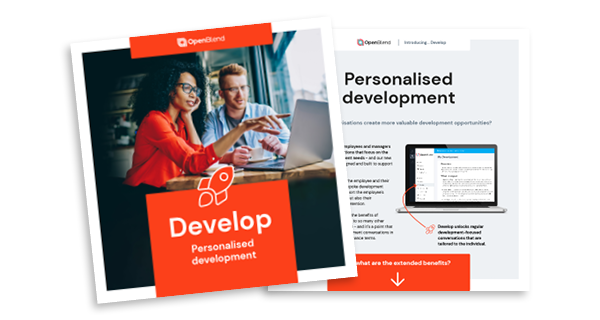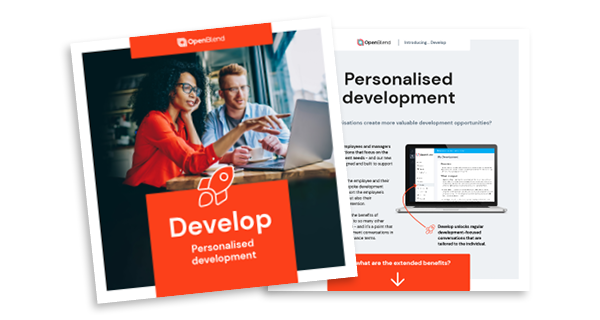Introducing 'Develop'
There are few things as demotivating as inertia: that feeling of standing still when the world is moving around you. In today’s workforce, development – the continuous progression of our skills and ability – has become a critical factor in engagement and retention, not to mention performance. That’s why OpenBlend has launched a 'Develop' module, specifically designed to help managers drive professional growth by guiding employees through personalised development conversations that benefit both the individual and the business.
Here, we explain why development matters, and how OpenBlend will help your managers impact career advancement through effective 1:1 conversation.
What is employee development?
Employee development is any process of upskilling and educating employees. A lot of definitions specify that employee development relates first and foremost to training that benefits the company, but at OpenBlend (and any forward-thinking organisation – including our customers) we recognise that successful employee development is more complex than that.
Employee development isn’t just a tick-box exercise to make sure your employees are adequately trained to your business’ needs. It’s a personal journey for each employee: one that can increase employee engagement as well as improve day-to-day performance in your business.
Yes, a good employee development programme will get results for your organisation, helping you to fill skill gaps, reduce attrition and future-proof your workforce, but it should also enable your employees to explore areas in which they want and need to develop, in order to boost their engagement with your organisation and encourage talent retention.
Those who take this people-centric approach to development also often find it facilitates growth in unexpected ways, with well-developed individuals bringing new and exciting skills and perspectives to their roles. According to Deloitte, organisations with a strong learning culture are 92% more likely to develop innovative products and processes than those without.
How should you approach employee development?
Employee development should ideally be part of regular performance management 1:1s for every employee. It should present a continuous learning curve for employees, with formalised development plans and training built into every employee’s journey with the business – regardless of what they want long-term from their role.
Personalisation is important. While in the past, training and development may have been seen as important only when it directly impacted the business (e.g., if an employee is on a leadership pathway or is underperforming in some way) in today’s workforce it must be much more holistic, playing an important role in engagement, retention and wellbeing.
Listening to what individual employees expect in terms of their professional growth alongside their training and development is critical to forging stronger connections with employees, and experiencing a better, more engaged performance in return. This also promotes self-awareness in development, which is key to setting achievable development goals that both the business and employee can see value in.
Even for those employees who don’t directly prioritise development as an intrinsic motivator, setting a collaborative development plan is critical to making sure every individual is skilled in their role and able to evolve with the business.
Why does employee development matter?
Development is a key contributor to employee performance, engagement and retention – and, when it isn’t prioritised, a major reason for high attrition rates.
LinkedIn’s 2023 Workplace Learning Report described a ‘crave for learning’ in today’s workforce, with the 18-34 bracket (that’s roughly a third of the UK workforce) saying they value learning and development opportunities above all else, even work-life balance. According to the same report, two of the most significant motivations for employees to engage in learning are 'making progress towards their career goals' and 'personalised learning for interests and career goals,' while three of the top five factors that people consider when pursuing new jobs reflect their desire to stretch, grow, and develop new skills.
It makes sense. The world of work is changing around us at a rapid pace. The impact of technologies like AI are disrupting the market at a faster speed than many expected. For younger people, at the start or mid-way through their career, it’s becoming clear that to succeed and secure employment satisfaction for the future, constant development is critical.
Besides, who really likes the feeling of statis? Of potentially spending 25% of your time each week in a job that, when it’s time to move on, you feel like you haven’t progressed in at all? Same job, same level, same skills…all those months and years, with little aside a pay cheque to show for it. With the lines between work and life continuing to blur, having a sense of fulfilment and satisfaction is essential to most people in their jobs today. Constant development is one way to achieve this.
What are the benefits of employee development?
The most notable benefits of employee development are:
- Improved retention. People are more likely to stay with a company that offers continuous training and development. A 2022 Workplace Learning & Development Trends survey by the Society for Human Resource Management found that 76% of employees are more like to stay if development opportunities are offered. You can read more statistics around this in our guide.
- Increased engagement. If employers tailor and personalise development to the employee’s specific needs, they will feel more recognised and supported. A study by Udemy found that 80% of employees agreed that the right learning and development would make them more engaged at work.
- Better performance. Unsurprisingly, the more employees are developed, the better their skills, understanding and ability to deliver and perform. That Deloitte study mentioned earlier also found businesses with a strong learning culture are 52% more productive and 56% more likely to beat their competitors to the market with new products and services.
How to introduce an effective employee development strategy
An effective employee development strategy needs to be reciprocal between the employee and the employer. It needs to deliver on both the business’ outcomes and the personal expectations and needs of the individual.
This is at the heart of OpenBlend’s new Development module. It’s designed to enable managers to identify unique development needs, create personalised plans around them and give employees the support they need to achieve their development goals.
We’ve built our Develop module around three key stages:

1. Discover.
Where is the employee now, and where do they need to be?
During 1:1 conversations, managers and employees explore the employee’s strengths, priorities, and things they most enjoy about their role, as well as their challenges, areas they’d like to improve or feel more confident in and goals for the future – such as career progression or learning. They can then work together to discuss a development mission and appropriate timeframes. The discovery phase is the first step to building a personalised development pathway.
2. Create.
What is their journey going to look like?
This is where managers and employees move from ideation to creating a clear, achievable and measurable development journey. This involves discussing and identifying 3-5 areas for development that need to be prioritised: this can include competencies, skills or behaviours like confidence and assertiveness. The manager and employee assess their current skill level, a target skill level, and any obstacles.
3. Progress.
What’s the best way to get there?
By this stage, the employee and manager have identified what their development plan needs to achieve. Now, they need to map a journey, timeline and goals that work for the employee using the GROW framework: Goal, Reality, Options, Way Forward. For instance, a development-focused performance objective could be to 'increase digital animation skills'. This is a broad objective, but by using the GROW framework it can be broken down into key stages that are essential to making and marking progress. Let's demonstrate:
Goal (G): Enhance proficiency in digital animation skills.
Reality (R): Assess the current level of ability, knowledge, and experience.
Options (O): What various strategies can be put in place to achieve the goal? Such as signing up for a relevant training course, participating in workshops, or practicing with specific software.
Way forward (W): To measure progress, define specific actions, set timelines and agree on milestones as markers towards the attainment of that goal.
Not only does the GROW framework help motivate employees, but it also helps visualise a path to achieving career goals more clearly.
How does OpenBlend’s approach to employee development work?
As with the OpenBlend platform, the ‘Develop’ module is purpose-built to support and recognise the individual and guide managers to getting the best results possible. The secret weapon in this process is OpenBlend’s unique, tailored approach to effective 1:1 conversation between managers and employees that has coaching frameworks like the GROW model built-in.
Develop works by guiding both the employee and their manager through logical and bespoke development conversations that not only support the employee’s growth and career progression, but also their engagement, performance, and retention. By using OpenBlend’s conversation funnel as the backdrop for development-focused conversations, managers are given support and resources to have open, honest conversations around development, while employees are given a safe space to explore their own development needs and reflect on their goals and challenges.
Combined with the full suite of OpenBlend tools, it’s a practical and structured way for managers and employees to set meaningful development plans that are measurable and achievable – boosting engagement, improving performance and reducing attrition.
You can learn more about Develop, our solution for employee development, its benefits, and how to use it in our new product guide.











